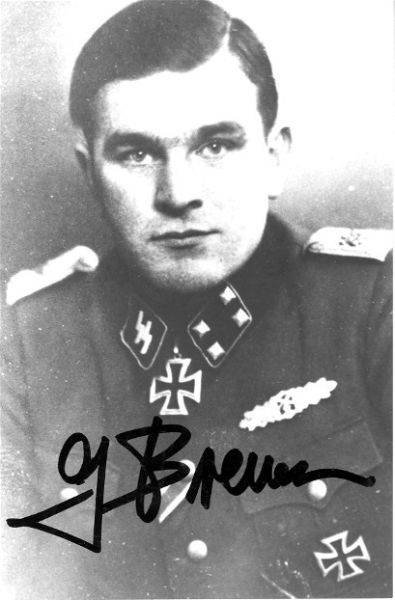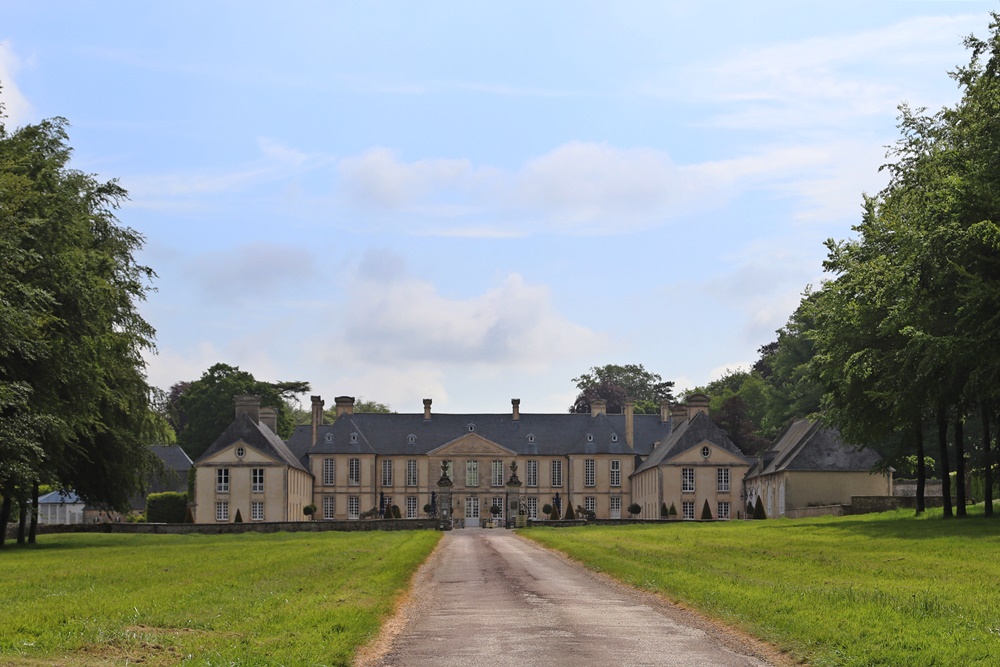Bremer, Gerhard "Gerd"
- Date of birth:
- July 25th, 1917 (Düsternthal, Germany)
- Date of death:
- October 29th, 1989 (Denia/Las Rotas, Spain)
- Service number:
- SS-Nr.: 310.405 // NSDAP-Nr.: 5.274.225
- Nationality:
- German
Biography
Bremer attended Alfeld Gymnasium and the NPEA Plön, graduating in 1936. That year, he joined the SS-Standarte Germania and later the Nazi Party. In 1937, he trained at the SS-Junkerschule in Bad Tölz and was assigned to the Leibstandarte SS Adolf Hitler, participating in the 1938 occupation of the Sudetenland.
Bremer fought in Poland, France, Yugoslavia, Greece, and the Soviet Union. He earned the Iron Cross (First and Second Class) and the Knight’s Cross for his role in capturing Mariupol in 1941. He rose to SS-Hauptsturmführer and commanded units in the 12th SS Panzer Division "Hitlerjugend," notably during the Normandy campaign. He was implicated in war crimes, including the execution of Canadian POWs at Putot-en-Bessin.
In 1944, he received Oak Leaves to the Knight’s Cross for actions during the retreat from Falaise. He later fought in the Ardennes and Hungary before surrendering to Soviet forces near St. Pölten in 1945.
Released from French captivity in 1948, Bremer moved to Denia, Spain, in 1954. There, he developed a bungalow settlement popular with German expatriates, including several former SS officers and war criminals. He died in Alicante in 1989 and was buried in Denia.
Promotions:
09.11.1938: SS-Untersturmführer
01.09.1940: SS-Obersturmführer
21.06.1942: SS-Hauptsturmführer
30.01.1944: SS-Sturmbannführer
00.00.1945: SS-Obersturmbannführer
Career:
00.00.1936: RAD
01.10.1936: Freiwilliger, III. Sturmbann, SS-Standarte „Germania", Wolterdingen
00.00.1937: SS-Junkerschule Bad Tölz
00.10.1938: SS-Untersturmführer, Zugführer, 10. Kompanie, Leibstandarte SS „Adolf Hitler", Berlin-Lichterfelde
00.11.1938: campaign in the Sudetes
00.00.1939: campaign in Poland
00.00.1940: campaign in France
00.00.1941: campaign in the Balkans
Kdr, 1. SS-Kradschützen Kompanie, SS-Aufklärungs-Abteilung 1, LSSAH
00.06.1943: Kdr, III. Bataillon, SS-Panzer-Grenadier-Regiment 26, 12. SS-Panzer-Division 'Hitlerjugend'
00.04.1944: Kdr, SS-Panzer-Aufklärungs-Abteilung 12, 12. SS-Panzer-Division 'Hitlerjugend', campaign in Noromandy and Falaise
00.12.1944: Ardennes offensive
00.02.1945: Operation Spring Awakening / Unternehmen „Frühlingserwachen" in Hungary
00.05.1945: battle of Vienna, near Sankt Pölten, Austria
08.05.1945: US POW, handed over to the French government
00.07.1948: released
Do you have more information about this person? Inform us!
- Period:
- Second World War (1939-1945)
- Awarded on:
- October 1st, 1939
- Period:
- Second World War (1939-1945)
- Awarded on:
- June 7th, 1940
- Period:
- Second World War (1939-1945)
- Rank:
- SS-Obersturmführer (Lieutenant)
- Unit:
- F�hrer, 1.(Kradsch�tzen), Aufkl�rungs-Abteilung 1, 1. SS-Division "Leibstandarte Adolf Hitler, XXX. Armeekorps, II. Armee, Heeresgruppe S�d
- Awarded on:
- October 30th, 1941
Bremer�s Kompanie first secured the village of Fredowka on the 05.10.1941. Then his Kompanie charged a bridge that was full of retreating Russians, which engineers promptly blew while their men were still on it. Despite this Bremer was able to find a crossing point over the river less than an hour later. His Kompanie continued the dash, seizing multiple villages and even capturing the staff of the Soviet 9th Army on the 06.10.1941. As the Division drew closer to Berdjansk, Bremer�s Kompanie intercepted a Russian column of 2,000 men and scattered it, while capturing 500 men in the process. Finally, Bremer�s company led the way into Mariupol on the 08.10.1941, which was secured a few days later.
It can be assumed that this approximately five-day dash (03.-08.10.1941) was the main justification for Bremer�s award of the Knight�s Cross.
633rd award.
- Period:
- Second World War (1939-1945)
- Rank:
- SS-Obersturmführer (Lieutenant)
- Awarded on:
- May 12th, 1942
Awarded with the bronze version
- Period:
- Second World War (1939-1945)
- Rank:
- SS-Hauptsturmführer (Captain)
- Awarded on:
- September 21st, 1942
- Period:
- Second World War (1939-1945)
- Rank:
- SS-Hauptsturmführer (Captain)
- Awarded on:
- November 25th, 1943
- Period:
- Second World War (1939-1945)
- Rank:
- SS-Sturmbannführer (Major)
- Unit:
- Kdr, SS-Panzer-Aufklärungs-Abteilung 12, 12. SS-Panzer-Division 'Hitlerjugend'
- Awarded on:
- August 30th, 1944
Award 617/2
- Period:
- Second World War (1939-1945)
- Rank:
- SS-Sturmbannführer (Major)
- Unit:
- Kommandeur, SS-Panzer-Aufklärungs-Abteilung 12, 12. SS-Panzer-Division "Hitlerjugend"
- Awarded on:
- November 25th, 1944
- Period:
- Second World War (1939-1945)
- Rank:
- SS-Sturmbannführer (Major)
- Unit:
- Kommandeur, SS-Panzer-Aufkl�rungs-Abteilung 12, 12. SS-Panzer-Division �Hitlerjugend�, 6. SS-Panzer-Armee, Oberbefehlshaber West
- Awarded on:
- November 26th, 1944
�During the first days of the Invasion the SS-Pz.Aufkl.Abt. 12 conducted a flank protection mission along the line Audrieu�Tilly sur Seulleswith great and far-reaching success. However the unit sustained heavy losses throughout both this operation and in the subsequent fighting around Caen (in which it served as a ready reserve). The understrength Abteilung was thus dispatched to the area around Rugles (10 km northeast of Laigle) on the 28.07.1944 to partially refit.
While in this area the commander of the Abteilung, SS-Sturmbannf�hrer Bremer, received word from routing friendly troops about a thrust by strong enemy tank forces from the Laval area in the direction of Chartres. Upon hearing this he immediately dispatched all available forces to reconnoiter this enemy force. By doing this the higher commands learned of enemy transmissions that were sent in the clear. The hostile advance was consistently delayed by the reconnaissance patrols that remained in constant contact with the enemy.
After friendly blocking formations had occupied the line Laigle�Verneuil the Abteilung was ordered to move to the Evreux area by the Division on the 15.08.1944 so as to resume an accelerated refitting. As a result of independently dispatched reconnaissance at the line Dreux�Houdan�Mantes the Abteilung spotted a northward thrust by enemy armoured forces along both sides of the Eure river at a relatively early time. The available weak forces, together with the support of Kampfgruppe Wahl, subsequently occupied a blocking line at the Eure river. The tireless and skillfully executed reconnaissance brought about a clear understanding of the enemy situation and significantly delayed their forward advance.
These measures were taken by SS-Sturmbannf�hrer Bremer on his own initiative and in an unclear situation. They decisively contributed to the prevention of the enemy�s intent to cut off major friendly forces while they were still withdrawing on the western side of the Seine. He and his weak forces tied down much larger enemy forces, delayed their advance and inflicted significant losses. He personally applied himself to the combat on a continual basis in a ruthless and exemplary fashion.
I hold Bremer as worthy of being awarded the Oakleaves to the Knight�s Cross of the Iron Cross on account of his unconditional readiness for duty and the bravery that he has repeatedly demonstrated while in difficult situations.�
668th Award
Sources
- Photo 1: Willi Schumacher Collection
- - LUTHER, C.W.H., Blood and honor, Schiffer Publishing Ltd, 2012.
- MARGOLIAN, H., Conduct Unbecoming.
- MOONEY, PETER, Waffen-SS Knights and their Battles, Schiffer Pub Ltd, 2008.
- Die Ordensträger der Deutschen Wehrmacht (CD), VMD-Verlag GmbH, Osnabrück, 2002
- Kwasny A., Kwasny G., Die Eichenlaubträger 1940-1945 (CD), Deutsches Wehrkundearchiv, Lage-Waddenhausen, 2001
- Patzwall K., Scherzer V., Das Deutsche Kreuz 1941-1945, Geschichte und Inhaber Band II, Verlag Klaus D. Patzwall, Norderstedt, 2001
- Schneider J.W., Their Honor was Loyalty!, R. James Bender Publishing, 1977
- Timo Worst















